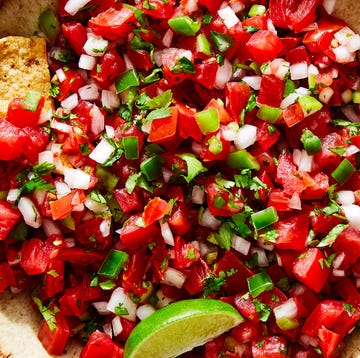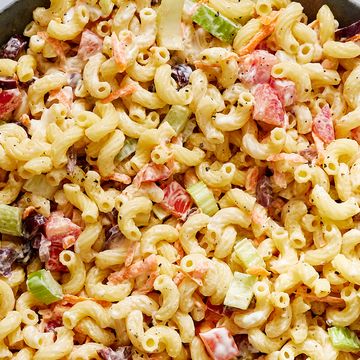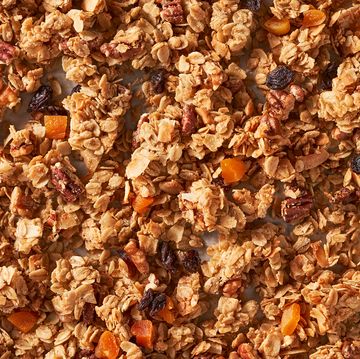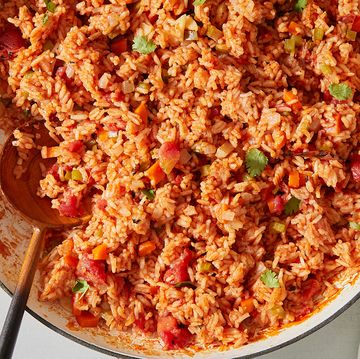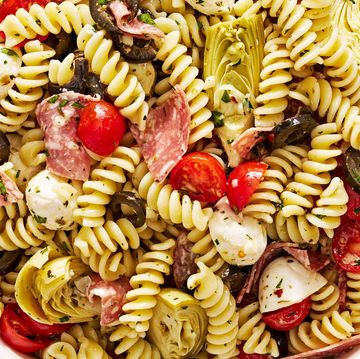All Creole cuisine packs a flavor punch that keeps you coming back for more, but red beans and rice are in a league all its own when it comes to Louisiana food staples. Most of the heavy lifting in the flavor department comes from the addition of chopped smoked ham and andouille sausage, but the backbone of this dish is that holy trinity of Southern cooking: onions, celery, and bell pepper. The red beans soak up all the smoky, porky, spicy, earthy flavors and release some starch in the doing, creating a rich gravy that’s perfect for spooning over steamed white rice.
What People Are Saying:
"The flavor is very rich, great family dinner!" - BakingInBKLYN
"I couldn't stop eating it. This is the type of situation where you find yourself eating the leftovers cold the next morning for breakfast–straight out of the Tupperware." - childofthecorn5
How To Make Louisiana-Style Red Beans & Rice
INGREDIENTS
- Red Beans: The heart and soul of this dish, dried red beans—not to be confused with kidney beans—are perfect for soaking up all the smoky, spicy flavors as they slowly simmer away. The beans are smaller, creamier, and less starchy than kidneys, with thinner skins that allow them to break down just the right amount to produce a velvety sauce.
- Smoked Ham: Smoked ham infuses the beans and their broth with a deep savoriness and subtle sweetness. To coax maximum flavor from the ham, I brown it briefly in a skillet before adding it to the beans.
- Andouille Sausage: Red beans adore smoke and spice, and andouille packs plenty of both. This spicy, smoked Cajun sausage is seasoned with garlic, paprika, and black pepper, among other things, and has a distinctive kick and intense smokiness that harmonize beautifully with the rich flavors of the beans and ham.
- Onion, Celery & Bell Pepper: Known as the "holy trinity" of Cajun cooking, this trio forms the aromatic foundation of the dish; think of it as a mirepoix, only with bell pepper swapping in for the carrot. The yellow onion offers sweetness; the celery, a subtle bitterness; and the bell pepper, a mild grassiness. Together they are far greater than the sum of their parts and create a flavor base uniquely well suited to the robust, smoky, spicy dishes that typify Cajun cooking.
- Chicken Broth: I never pass up an opportunity to add flavor, so I use chicken broth instead of water to deglaze the skillet I cook the ham, andouille, and aromatics in. Using low-sodium broth is key, as it enriches the dish without overwhelming it with salt—particularly important because the ham and andouille pack a lot of salt of their own.
STEP-BY-STEP INSTRUCTIONS
Red beans and rice requires a bit of planning ahead to allow time for soaking the beans. I like to get things started the night before, but morning-of is fine, so long as you give the beans at least 8 hours to soak. Forget whatever you might have heard about not salting beans until the last minute. Soaking dried beans in well-salted water seasons them from the inside out; plus, it helps them maintain hold their shape without splitting during cooking. So, with that in mind, combine the beans with 10 cups water and 2 Tbsp. kosher salt in a large bowl or plastic container and let soak at least 8 hours. If soaking for longer than 12 hours, transfer to the fridge.
Once the beans are soaked, it’s time to cook them! Drain the beans in a fine-mesh sieve and rinse them under running water. Place the beans in a 5- to 6-qt. Dutch oven or other heavy pot and pour in 2 quarts water. Add the bay leaves and half of the chopped onion and bring to a boil. Reduce the heat and simmer, stirring occasionally, until the beans are tender, about 1 hour. About 15 minutes before the beans are done cooking, grab a wooden spoon and start mashing some of the beans against the side of the pot to release their starches and thicken the broth.
Toward to end of the bean cooking time, turn your attention to the pork and aromatics. Cut the ham into 1/2" dice. Heat 1 Tbsp. oil in a large skillet over medium-high and cook the ham, stirring occasionally, until browned, 7 to 9 minutes. Add the ham to the beans.
Slice the andouille into coins. Heat another tablespoon of oil in the same skillet (don’t wipe it out; we want those browned bits!) and cook the andouille, stirring occasionally, until starting to brown, 7 to 9 minutes. Transfer the andouille to the bean pot.
And now for the aromatics. Add the chopped celery, bell pepper, and remaining onion; season with 1/2 tsp. kosher salt. Cook, stirring occasionally, until the veggies start to soften, 4 to 5 minutes. Stir in the garlic and thyme and cook, stirring, until fragrant, 1 to 2 minutes more.
Before you scrape the aromatics into the beans, you’ll want to deglaze the pan. Pour the broth into the skillet and bring to a simmer, scraping up any browned bits from the bottom of the pan with a wooden spoon. Stir in the broth and aromatics into the bean pot. Continue to simmer the beans, stirring occasionally, until the liquid thickens to about the consistency of gravy, about 30 minutes more. Fish out and discard bay leaves before serving.
It wouldn’t be red beans and rice without rice! So, serve the red beans over rice and top with parsley.
Full list of ingredients and directions can be found in the recipe below.
Recipe Tips
- Are red beans and kidney beans the same thing? Tons of red beans and rice recipes call for kidney beans, but there are a few differences between red kidney beans and red beans. Red beans are smaller and plumper, with thinner skins and a creamier texture, when compared to the meatier, tougher kidney bean. Camellia is the go-to brand in the South, but of course, you can use whatever you can find at your local grocery store. If you’re in a pinch and seriously craving red beans and rice, kidney beans are a fine substitute, but they may need an extra 30 minutes of boiling to become tender.
- Do I need to soak my beans? Yes—you should soak your dry beans before cooking for a faster cooking time and easier digestion. Beans can soak on the countertop at room temperature for up to 8 hours. If you won’t be able to get to them right away, soak the beans in the refrigerator for up to 12 hours. Technically, you don’t have to use dried beans in red beans and rice, but using the dried variety gives you a chance to infuse the beans with flavor as they cook. Dried beans are also more nutritionally dense than canned beans.
Storage
Red beans can be cooked 3 days ahead. Let cool; cover and chill. Reheat over medium-low, adding more chicken broth to thin if needed.
















